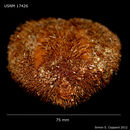Comprehensive Description
provided by Smithsonian Contributions to Zoology
Meoma ventricosa (Lamarck)
Spalangus venlricosus Lamarck, 1816:323. [For synonymy, see Mortensen, 1951:529, and Chesher, 1970:737. The biology and living habits have been described by Kier and Grant, 1965:38, and Chesher. 1969, 1970.]
This species occurs off Carrie Bow Cay in sand grooves in the reef and in the lagoon west of the island. Its distribution is sparse in the reef where only three specimens were found alive. It is quite common in the deeper water (over 7 m) in the sand fields of the lagoon where specimens reach their greatest size. Here the specimens live completely buried in the sediment. Although it occurs in Thalassia beds where the water is over 5 m deep, specimens are less common and smaller. Individuals are not completely buried in the sediment, presumably because the network of Thalassia roots prevents burial. Here the echinoid lives much like Clypeaster rosaceus.
Immature specimens were found along the transect in the Spur and Groove Zone in sand fields at a depth of 10 meters. The echinoids were buried in the sand, and were only 5.8 to 17.5 mm long. They occur with the young of Plagiobrissus grandis and can be distinguished from them by their black pedicellariae, darker color due to yellow tips on their spines, and red tubefeet in the anterior ambulacrum. No adults were found in this zone.
The changes from the growth of a specimen 7 mm long to adult dimensions have been described by Kier and Grant (1965) and Chesher (1969, 1970). Only the changes from the smallest specimen 5.8 mm long to one 17.5 mm long are described here.
APICAL SYSTEM.—The apical system is very large relative to the size of the test in the immature. The specimen 5.8 mm long has an apical system (Figure 6A; Plate 6: figure 1) with a width equal to 16 percent of the length of the test. In the specimen 17.5 mm long, the width of the apical system is only 9 percent of the length of the test. No genital pores are present in either of these specimens. Kier and Grant (1965:44) report small genital pores in a specimen of this species 44 mm long. Only a single madreporic pore is present in the specimen 5.8 mm long, but 27 occur in the specimen 17.5 mm long.
PETALS.—The petals are just beginning to be developed in the specimen 5.8 mm long (Figure 6A; Plate 6: figure 1). Each petal has only six to eight pores. All appear to be single, although some of them are constricted medially. This indicates that their bifurcation into pore-pairs would have occurred soon. The specimen 17.5 mm long (Figure 6C; Plate 6: figure 2) has well-developed petals with 35 to 36 pore-pairs in the anterior petals II or IV. Thirty-one to 33 pore-pairs compose posterior petals V or I.
PLASTRON.—Although the plastron is relatively wider in the immature than in the adult, this difference is not nearly as great as in Plagiobrissus grandis. The smallest specimen, 5.8 mm long, has a plastron (Figure 6B) whose width is equal to 45 percent of the length of the test. The width of the plastron in the specimen 17.5 mm long (Figure 6D) is 40 percent of the length, and in an adult it is 35 percent.
FASCICLES.—The peripetalous fasciole is very slightly developed in the smallest specimen (5.8 mm long) and is composed of a discontinuous single row of small tubercles (Plate 6: figure 1). This fasciole is well developed in the specimen 17.5 mm long and is composed of one to three rows of tubercles (Plate 6: figure 2).
The subanal fasciole is distinct in the smallest specimen and is composed of two rows of tubercles. The specimen 17.5 mm long has up to nine rows in this fasciole.
PEDICELLARIAE.—Approximately 10 globiferous pedicellariae (Plate 5) were present on the dorsal side of the specimens 5.8 mm and 17.5 mm long. They are very conspicuous on the smallest specimen because of their black color and easily distinguish the young of this species from the young of Plagiobrissus grandis. Although Mortensen (1951:531) reports no globiferous pedicellariae in an adult of Meoma ventricosa, Chesher (1969:99) has found them in an adult specimen from Bermuda.
- bibliographic citation
- Kier, Porter M. 1975. "The echinoids of Carrie Bow Cay, Belize." Smithsonian Contributions to Zoology. 1-45. https://doi.org/10.5479/si.00810282.206

